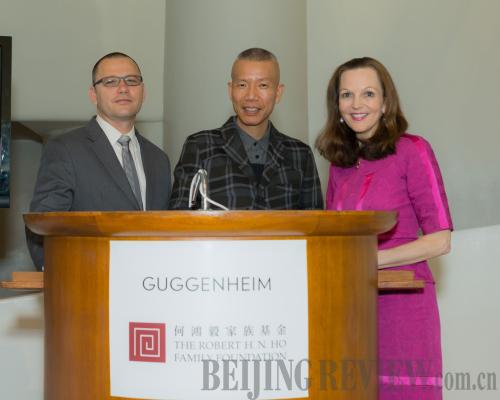|
 |
|
TRIO: Dr. Thomas J. Berghuis, Future Robert H. N. Ho Family Foundation Curator of Chinese Art; Cai Guoqiang; and Alexandra Munroe, Samsung Senior Curator of Asian Art, Solomon R. Guggenheim Foundation (left to right) (KRIS McKAY © SOLOMON R. GUGGENHEIM FOUNDATION) |
Walking into the cavernous space of New York's Guggenheim Museum, contemporary artist Cai Guoqiang looked up to the ceiling where he once hung full-sized cars exploding into colorful electric fireworks and said it felt like "visiting a former lover."
"The time I spent in this museum was very significant to my career," he said. "Like a beacon, it lights up myself and allows me to see my past, present and future." Cai is a Chinese national based in New York City and the world's foremost gunpowder artist who dazzled millions with his fireworks display at the opening ceremony of the Beijing Olympics in 2008 and some other events.
As one of the honorary advisors to the Robert H.N. Ho Family Foundation, Cai said new "love stories" will be written for this iconic space. And now, more than ever, the newest expressions of China's artistic soul will reach a global audience. The foundation, created in 2005, is a Hong Kong-based independent philanthropic organization committed to promoting Chinese culture and Buddhist philosophy.
A reportedly $10 million grant from the foundation—its largest grant ever—has been given to the Guggenheim to commission new works from Chinese artists. The works will enter the museum's permanent collection to provide the public a chance to experience China's emerging artistic identity.
Global stage
The timing of this flood of investment into Chinese contemporary art is no accident. Over the past 20 years, Chinese art has soared to where it is today, Cai said, as a "platform for new possibilities."
"Chinese culture cannot be represented solely by art from the past," said foundation chief executive Ted Lipman, adding the Chinese art world has "come a long way since 1979." As the country's economy takes off, so has the creativity of its newest generation of artists. Arts and culture are growing by "leaps and bounds," he said.
"Contemporary art is a gateway to understanding China," he added.
The foundation sees Chinese culture as a long continuum, Lipman said, "From the ancient, classical culture that many people are familiar with to a living and growing culture of much influence."
Emerging artists from China have become hot commodities in the international art world. Auction sales in Hong Kong have reportedly quadrupled over the past five years, with contemporary works leading sales. In 2008, artist Zeng Fanzhi sold a piece from his Mask Series 1996 for a record $9.7 million. In 2010, Asia accounted for nearly a quarter of global auction revenue. A piece by artist Fang Lijun sold for $2.8 million—three times its pre-sale estimate—at a 2011 Hong Kong auction. The total value of contemporary Chinese art sold at auctions has grown from less than $1 million in 2002 to $167 million in 2010, according to art mark advisors ArtTactic.
"And this figure could easily be double if you take into account pieces sold through galleries and art fairs," ArtTactic Managing Director Anders Petterson told BBC news.
Leading the vanguard are artists like Li Liao, 30, who worked at a Foxconn factory for 45 days and purchased the iPad Mini model he had been assembling for display in an exhibit called Consumption at the Ullens Centre for Contemporary Art in Beijing. Another contemporary artist, He Xingyu, constructed a tank made out of tan leather for the same show, called ON/OFF: China's Young Artists in Concept and Practice.
Today's generation of young Chinese artists have grown up in a country that is changing rapidly from day to day, and have come to be defined more by their differences than their commonalities, Philip Tinari, Director of the Ullens Centre, told The Economist. These artists are newly confident to make art that ostensibly has nothing to do with China and reflect a multiplicity of concerns and influences.
| 